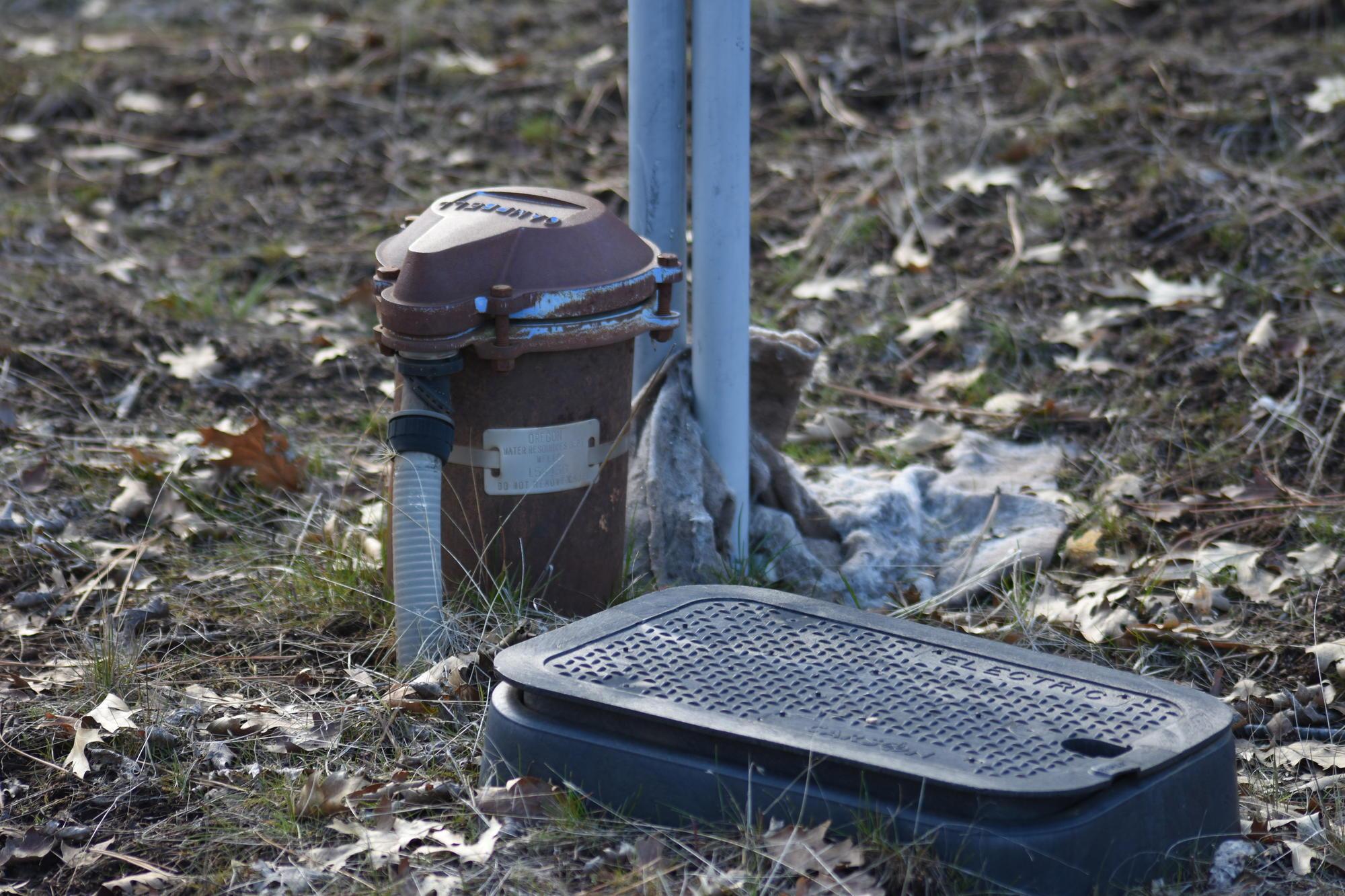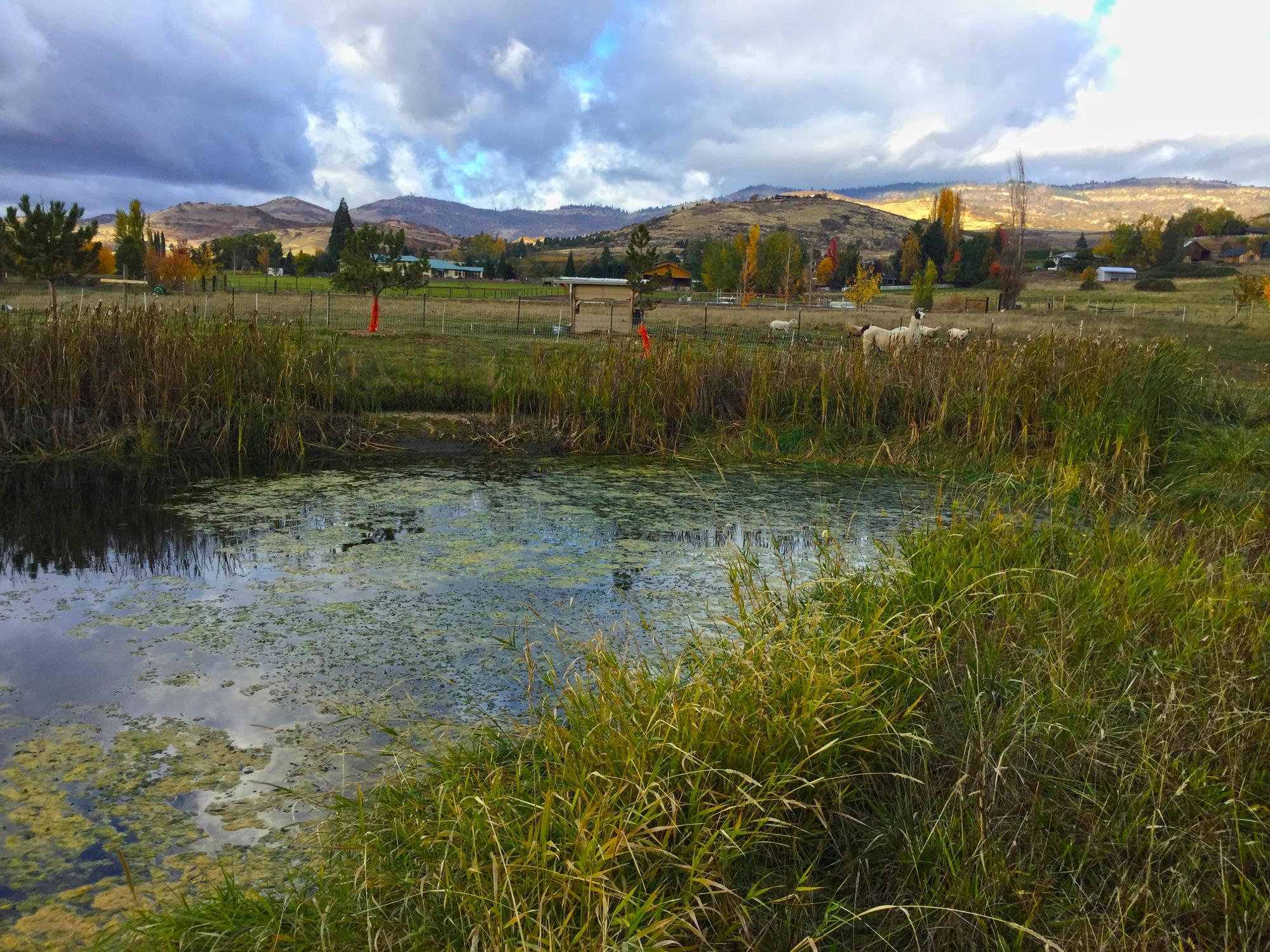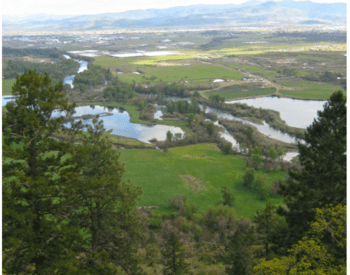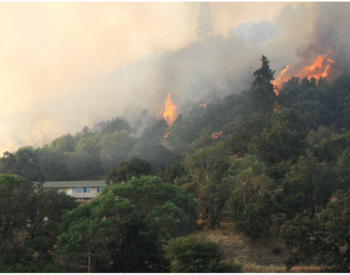Everyone needs high-quality water, but water is a limited resource. These best practices for wells, ponds and other water systems can help you secure a safe, reliable water supply adapted to your needs. These practices also help to ensure that we protect our streams, lakes and groundwater.
Wells
The useful life of a well can extend for decades with little or no trouble, but a variety of factors can lead to problems. These steps can help:
- Periodically check the flow of the well to make sure that it remains good.
- Periodically test for contaminants in wells used for potable water. The quality of the water can change over time. Regulations require that well owners test for coliform bacteria, arsenic and nitrate during real estate transactions. It may be important to test for other contaminants as well.
- Make sure wells are sited appropriately.
Wells may need maintenance at any time of
year. Consider the consequences if a well fails and you can’t get to it in snowy conditions or when dry grass creates a fire hazard in the summer.
Springs
- Periodically check the flow of your spring and test for contaminants. The performance of a spring can change seasonally and from year to year.
- Maintain the integrity of spring boxes. Developing a spring means constructing facilities to help get the water from the ground into your delivery system. Most spring boxes gather water in an enclosed structure, preventing contact with rodents and mosquitoes.
- Consider installing treatment systems if the water is used for potable purposes. This depends on the quality of the spring water and the security of the spring box and other parts of the system.
Agricultural irrigation water
- Use water wisely. Whether water is supplied from surface water, an irrigation district, or from wells, a key management practice is efficient delivery that minimizes waste. Water conservation in agricultural applications has the potential for large savings.
- Screen surface water intakes to keep fish out. Intakes located in the watercourse should be screened wherever surface water diversions are used.
- Reduce contamination. Excess water moving off farmed areas can be a significant source of contaminants to our streams, rivers and groundwater. Consider these steps to cut down on contamination:
- Practice farming techniques that minimize soil loss and keep sediments out of waterways.
- Practice techniques that minimize the amount of percolation to groundwater to help keep groundwater clean.
- Apply the least amount of fertilizer necessary. Excessive fertilizer can run off to surface waters or seep into the groundwater and become pollutants.
- Exercise caution when using herbicides and pesticides. Do not allow these products to enter surface or groundwater. Herbicides and pesticides should not be used as an automatic first choice; use them only as one part of an Integrated Pest Management strategy that considers multiple management tactics.
Ponds
Ponds offer enjoyment and can serve a variety of purposes, but they commonly fail over time for a number of reasons. They can cease to hold water due to burrowing animals, pond liner failure and erosion. Inlet, outlet and overflow facilities can also fail. Ponds accumulate silt and other debris over time, decreasing their capacity.
Ponds can develop water quality problems, including stagnation and odors. They can be havens for mosquitoes, and submerged and floating aquatic vegetation can become a nuisance. Here are some steps that can help:
- Prevent stagnation. If stagnant water is not acceptable, try aerating the water, harvesting excessive weeds and removing accumulated sediments.
- Dredge responsibly. If sediments are dredged, check with the Department of Environmental Quality regarding proper disposal of dredged material. It may also be necessary to control pests such as mosquitoes.
- Prevent runoff and manage nutrients. Excessive nutrients, such as nitrogen and phosphorous, often cause water quality problems. Excess nutrients are difficult to remove from ponds, since these nutrients will continue to be cycled through the water column and sediments. Dredging sediments and removing vegetation can help, but these efforts could fall short. One key management practice is to prevent runoff from lands receiving fertilizer applications from entering ponds.
- Avoid invasives. Exotic species of plants and animals can create serious problems in our natural waterways. When ponds overflow and come into contact with other surface waters, invasive plants like parrot feather, yellow flag iris and purple loosestrife can spread.
If the pond is suspected of being contaminated or of having warm water, check with the Department of Environmental Quality for guidelines on proper removal or release of the water.
Septic systems
When constructed and maintained in accordance with state standards, septic tanks and drain fields are usually reliable and safe for the environment. However, in certain situations, they can contribute excessive nitrate to groundwater. Failure that results in surfacing of wastewater can lead to odor, nuisances and pollution.
Septic tanks rely on bacteria to break down wastes, and it is important to keep the bacteria healthy. Keep harmful chemicals and materials from entering the system.
Avoid or reduce the use of bleach. Small amounts of cleaning bleach will do little harm, but putting a large amount in the system could affect its biology.
- Avoid fats, oils, grease and excessive food waste (typically associated with heavy use of in-sink garbage disposals). While food wastes will not harm the biology in the septic tank, the wastes will cause the tank to fill up faster than necessary.
- Keep recreational vehicle waste out of septic tanks.
- Keep plastics and other wastes that don’t decompose out of the system.
- Carefully consider the use of additives. Some additives promise to enhance septic systems but are typically unnecessary.
- Pump the solids out of the septic tanks every few years, depending on use. If tanks fill with too many solids, they will not work properly.
- Keep trees and woody vegetation off drain fields because their roots can damage parts of the system. Encourage grasses on drain fields. Paving, vehicular traffic, structures, and large animals should also be kept off the drain fields.
- Site septic systems appropriately. Note that these systems can need maintenance at any time of year. Don’t put a septic tank in a location that would make it difficult to pump out every few years.
Rainwater harvest systems
Consult Oregon Smart Guide: Rainwater Harvesting, published by the Oregon Department of Consumer and Business Services. Systems that meet the recommendations in this manual are using good management practices. These practices address ways to keep the water free of debris and mosquitoes, allow the rainwater systems to be easily cleaned, and prevent freezing problems in the winter.
Most rainwater harvest systems are not intended to provide potable water, but it is possible for misunderstandings to happen. Nonpotable systems should be clearly identified with signs, or by painting pipes purple.
Graywater systems
Keep harmful chemicals out of graywater systems. Depending on the uses of the graywater and the configuration of the system, chemical-free practices may be even more critical to graywater systems than they are to septic systems. Generally, graywater systems are highly regulated, and following the regulations results in excellent management practices.
Stormwater drainage systems
The way in which stormwater moves through and away from structures and developed areas can be critical.
- Use pipes and ditches to convey stormwater away from buildings. Water can damage structures.
- Control water velocity to prevent erosion of soils. Use retention basins, berms and drop structures to control velocity as water is conveyed.
- Make sure that stormwater doesn’t pick up contaminants. The flow should not be routed through areas that contain stored manures, chemicals, or fuels.
- Keep waste out of stormwater. Encourage stormwater to percolate into the ground through facilities such as permeable pavement.
- Try a rain garden. Vegetative systems can enhance water quality, slow the movement of water and encourage percolation. Examples of vegetative systems include rain gardens, bioswales and buffer strips.
For drainage considerations outside developed areas, see other publications in this series in the OSU Extension Catalog.
Infrastructure management
These management practices apply to all of the above water facilities.
- Practice conservation. Surface water and groundwater are precious resources, and it is important to conserve water. At home, use water-saving appliances, along with low-flow showers, faucets and toilets. Outdoors, consider using drip irrigation systems.
- Conduct inspections. Water systems contain working parts, such as pipes, pumps, and a variety of mechanical and electrical equipment. To keep the systems functioning properly, periodically inspect parts of the systems and maintain them in good working order.
- Document the location of underground pipes, tanks and other facilities. It is easy to forget where things are buried years after the work is done. Marked maps and photos are good tools. When installing new systems, try using metallic tracer wire with plastic pipe so that metal detectors can locate pipes in the future.
- Keep operation and maintenance instructions. One good management practice is to organize a comprehensive set of instructions for the systems. The instructions should include published information supplemented with site-specific needs.
- Develop contingency plans. For critical systems, it is important to know how to respond in the event of a failure. For example, if a home is served by a single well and has no other source of potable water, the homeowner should know how to respond in the event of a well failure.
Follow the rules
In general, water systems are highly regulated by a variety of state and local agencies. Here are some regulatory highlights for the different types of systems.
Wells
Water wells are permitted by the Oregon Department of Water Resources in accordance with specific standards.
- Approval for construction of domestic wells is nondiscretionary; as long as the well meets state standards, it is allowed. The standards address where wells can and cannot be located, and how they must be constructed.
- Wells must be constructed by a licensed and bonded well driller or by a landowner who has applied for and received a Landowner’s Water Well Permit, as well as a landowner bond. Landowners or drillers must also follow reporting requirements during construction.
- Single-family residences served by wells can use up to 15,000 gallons per day for domestic purposes; those wells can also be used to irrigate up to a half-acre of noncommercial crops. Wells can also be used for up to 5,000 gallons per day for commercial purposes other than irrigation. Use of more water requires a water right permit, which may be difficult to obtain. The uses from a well that are allowed without a water right permit are limited per parcel (tax lot) or well system. (Regardless of the number of wells on a parcel or the number of parcels connected to a well system, the total exempt use remains the same: 15,000 gallons per day for domestic use, a half-acre of noncommercial irrigation and 5,000 gallons per day for commercial purposes).
- Within incorporated areas such as cities, ordinances generally prohibit private wells and require hookup to the municipal water supply system.
Springs
Landowners can use springs under certain limited conditions. If, under natural conditions, flow from the spring would normally leave the property, it is considered water of the state. In that case, spring water can only be used with a water right permit from the Department of Water Resources.
Surface water diversions
Surface water diversions require water rights permits issued through the Department of Water Resources. Water rights laws are complicated. Obtaining new water rights can be difficult and sometimes impossible.
Irrigation districts
Irrigation district deliveries are typically made under an agreement between the district and the landowner. The agreements specify the amount of water that can be used, the times it is available and the location where it is available. Watermasters also have oversight of irrigation district deliveries.
Ponds
Ponds are regulated by the Department of Water Resources. Pond regulations include:
- A primary water right permit is required for construction of ponds and to hold water in ponds. Larger ponds (levees over 10 feet high and storing more than 9.2 acre-feet of water) must have the dam/levee designed by a licensed engineer to ensure that the facilities are constructed in a safe manner. Smaller ponds also require a primary water right permit, but the dam does not need to be engineered.
- A secondary water right permit can be required to actually use the water in ponds unless the water is only used for purposes that are exempt. Stock watering is an example of an exempt use that does not need a secondary permit. Another exemption is the collection and use of rainwater as long as it is collected from artificial impervious surfaces.
- Ponds holding rainwater collected from artificial impervious surfaces do not need a primary or secondary water right permit as long as the storage facility is designed in a way that prevents any other type of surface water from entering the pond.
- Bulge ponds that temporarily store irrigation water may also be exempt from needing a permit. Consult with your local watermaster.
Septic systems
Septic systems are permitted by Oregon Department of Environmental Quality in accordance with state standards. The standards address where facilities can be located and design requirements.
- In certain situations, owners must have maintenance contracts with certified professionals.
- Most cities prohibit septic systems wherever is it possible to connect to a municipal wastewater collection and treatment system.
Rainwater
Rainwater can be collected and used as long as it has not touched the earth’s surface and is captured from an artificial impermeable surface. Once it comes in contact with the earth it becomes property of the state. State requirements for rainwater harvest systems vary depending on how the water is used:
If rainwater is for potable use, plumbing standards govern design of the system, and proper treatment is required.
Another set of plumbing standards applies if the water is used for nonpotable, nonirrigation purposes, such as flushing toilets or cooling water.
- If the rainwater is used for irrigation only, it is not regulated by the state under the plumbing code; however, local building officials may have special requirements, and your project may need to meet building and electrical standards.
Graywater
Graywater systems are subject to a stringent set of requirements by the Oregon Department of Environmental Quality. The extent of the requirements depends on the uses of the graywater. Permits and annual reporting and fees are required.
Stormwater
Stormwater regulations originate at the federal level under the Clean Water Act, which is administered by the U.S. Environmental Protection Agency.
- One set of requirements applies to municipalities that collect stormwater in piping systems and discharge to water courses. In Oregon, responsibility for municipal stormwater systems is delegated to the Department of Environmental Quality and then to the local municipalities. The cities of Medford and Ashland manage their own stormwater program, while Rogue Valley Sewer Services oversees the program on behalf of the cities of Phoenix, Talent, Central Point and urbanized parts of Jackson County. These programs have elements that address public education and outreach, control of illicit discharges and management of large construction projects (over 1 acre).
- Stormwater programs typically require compliance through implementation of management practices.
- While these programs are not required for rural homeowners, the principles and practices for managing stormwater are good for everyone.
Public drinking water
For information on public drinking water systems, contact the Oregon Health Authority and the Oregon Department of Environmental Quality. OHA regulates drinking water systems, and DEQ has a source water protection program to help protect the quality of drinking water supplies.
More OSU Extension publications
Angima, S. Harvesting Rainwater for Use in the Garden, EM 9101.
Bowers, S. Woodland Ponds: A Field Guide, EM 9104.
Cahill, M., D. Godwin, J. Tilt. Rain Gardens: Low-impact development fact sheet, EM 9207.
Lucas, C., M. Livesay, Keeping Your Well Water Well, EM 8752.
Lucas, C., M. Livesay, Twelve Simple Things You Can Do to Protect Your Well Water, EM 8651.
More resources
Oregon Department of Environmental Quality: information on septic systems, graywater systems and stormwater permitting. See the Septic Smart page.
Oregon Water Resources Department: information on wells, water rights, dams, water law, water conservation, and more.
Oregon Department of Consumer and Business Services, Oregon Smart Guide, Rainwater Harvesting.
Rogue Valley Council of Governments: a variety of resources related to stormwater under the heading Natural Resources.
Rogue Valley Sewer Services: a variety of resources related to stormwater under the heading Stormwater Quality.
Stream Smart: information on stormwater
© 2019 Oregon State University.
Extension work is a cooperative program of Oregon State University, the U.S. Department of Agriculture, and Oregon counties. Oregon State University Extension Service offers educational programs, activities, and materials without discrimination on the basis of race, color, national origin, religion, sex, gender identity (including gender expression), sexual orientation, disability, age, marital status, familial/parental status, income derived from a public assistance program, political beliefs, genetic information, veteran’s status, reprisal or retaliation for prior civil rights activity. (Not all prohibited bases apply to all programs.) Oregon State University Extension Service is an AA/EOE/Veterans/Disabled.













